About Joy
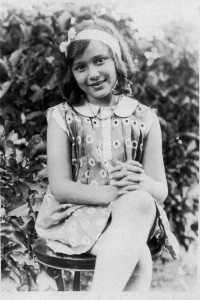 Joy Kingston started life as Arline Joy Koenigsdorf. She was the second child born to Henry and Dorothy Koenigsdorf on December 6, 1922 in Kansas City, Missouri. Joy’s father and grandfathers were successful small businessmen in the community and this afforded young Joy the opportunity to cultivate any extra-curricular activities that she desired. Joy was an unusually artistic and intelligent child and was considered to be quite pretty as both a girl and as a young woman. Joy always gravitated toward the realm of fashion, the arts and things of beauty. She was always highly motivated even as a girl. To her parents’ surprise and without their prompting, Joy obtained a part time job working after school in a ladies’ clothing store. She was assigned the lofty responsibility of picking up pins that had been dropped by the seamstresses who were busy sewing fine ladies garments. It’s hard to imagine that retrieving renegade pins would lead to Joy ultimately scaling the heights of the fashion world.
Joy Kingston started life as Arline Joy Koenigsdorf. She was the second child born to Henry and Dorothy Koenigsdorf on December 6, 1922 in Kansas City, Missouri. Joy’s father and grandfathers were successful small businessmen in the community and this afforded young Joy the opportunity to cultivate any extra-curricular activities that she desired. Joy was an unusually artistic and intelligent child and was considered to be quite pretty as both a girl and as a young woman. Joy always gravitated toward the realm of fashion, the arts and things of beauty. She was always highly motivated even as a girl. To her parents’ surprise and without their prompting, Joy obtained a part time job working after school in a ladies’ clothing store. She was assigned the lofty responsibility of picking up pins that had been dropped by the seamstresses who were busy sewing fine ladies garments. It’s hard to imagine that retrieving renegade pins would lead to Joy ultimately scaling the heights of the fashion world.
In high school, Joy modeled fashions for ladies’ specialty shops in Kansas City, Milwaukee and Chicago and actively pursued her interest in journalism and fine arts at school. She graduated from high school early at age 15 in June of 1938. For one year she studied at the University of Missouri. Then in 1939 she enrolled at the University of Wisconsin where she was an art major in the School of Home Economics, with an emphasis on dress design and interior decoration. Both of these areas would be lifelong passions for Joy. Subsequently, Joy also studied for one semester at the Kansas City Art Institute.
 After completion of her studies, Joy began what would be a long and very interesting career in fashion. Initially, she worked for several Kansas City-based fashion houses: Nelly Don and Quality Hill. She then left Missouri to work for the well-known firm, Nardis of Dallas, Texas. After WWII, the fashion industry in Dallas was very active and prosperous, and highly popular brands had production facilities there. It was there that Joy’s career flourished and she made great strides very rapidly. At age 25, Joy was named Design Director for Nardis and was earning the substantial and staggeringly high annual salary of $25,000. This was quite an accomplishment for a young woman with only two years working experience. Her creative talent as fashion designer was obvious, but she also had an innate business acumen that would propel her to her next venture. She knew that her ability would take her far, but proper marketing was essential. With this idea, Arline Joy Koenigsdorf petitioned in court to have her name legally changed to Joy Kingston, a name that sounded far more elegant and sophisticated to her. Certainly, it did sound less Jewish in origin. While her father, Henry, was clearly and vocally not pleased with her decision, Joy knew unquestionably that this was what she wanted and she was not to be deterred.
After completion of her studies, Joy began what would be a long and very interesting career in fashion. Initially, she worked for several Kansas City-based fashion houses: Nelly Don and Quality Hill. She then left Missouri to work for the well-known firm, Nardis of Dallas, Texas. After WWII, the fashion industry in Dallas was very active and prosperous, and highly popular brands had production facilities there. It was there that Joy’s career flourished and she made great strides very rapidly. At age 25, Joy was named Design Director for Nardis and was earning the substantial and staggeringly high annual salary of $25,000. This was quite an accomplishment for a young woman with only two years working experience. Her creative talent as fashion designer was obvious, but she also had an innate business acumen that would propel her to her next venture. She knew that her ability would take her far, but proper marketing was essential. With this idea, Arline Joy Koenigsdorf petitioned in court to have her name legally changed to Joy Kingston, a name that sounded far more elegant and sophisticated to her. Certainly, it did sound less Jewish in origin. While her father, Henry, was clearly and vocally not pleased with her decision, Joy knew unquestionably that this was what she wanted and she was not to be deterred.
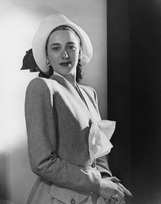 Joy always knew she wanted to have her own fashion line and with the help of business partner and fellow fashion designer, Marion Bren, she launched Madea of California. Based in Los Angeles, Madea’s specialty was ladies blouses and casual dresses at a medium price point. As expected, her products were very well received by the public. Joy’s signature use of unique fabrics became her trademark not only for her Madea product line, but for fashions that she created for the rest of her career. Buyers for leading clothing stores knew of Joy’s reputation from her days at Nardis and were quick to purchase the Madea product line. Unfortunately, the business relationship with Marion Bren didn’t last, but the demise of the Madea partnership allowed Joy the opportunity to create exactly what she wanted: Her own company and label. Joy Kingston of California was incorporated in August 1947 with business partner, Marvin Robman. Marvin handled the sales and operations while Joy was the Creative Design Director. That year, Joy was invited to become a member of the prestigious Fashion Group, a fashion trade organization. Joy’s signature use of interesting trims, fabrics and special details with a fresh color palette continues to earn her acclaim. While her profiles were classic and somewhat timeless, her interpretations were fresh, and at times even playful. Joy’s quest for the unique and special materials she demanded led her to both Europe and Asia where she traveled extensively. The European, Mediterranean, Polynesian and Asian influences were profoundly evident in her designs, yet her clothing was uniquely youthful and brimming with the comfortable, breezy panache that reflected sunny Southern California. In 1949, Joy was nominated as one of the top 19 designers of the year by the fashion industry.
Joy always knew she wanted to have her own fashion line and with the help of business partner and fellow fashion designer, Marion Bren, she launched Madea of California. Based in Los Angeles, Madea’s specialty was ladies blouses and casual dresses at a medium price point. As expected, her products were very well received by the public. Joy’s signature use of unique fabrics became her trademark not only for her Madea product line, but for fashions that she created for the rest of her career. Buyers for leading clothing stores knew of Joy’s reputation from her days at Nardis and were quick to purchase the Madea product line. Unfortunately, the business relationship with Marion Bren didn’t last, but the demise of the Madea partnership allowed Joy the opportunity to create exactly what she wanted: Her own company and label. Joy Kingston of California was incorporated in August 1947 with business partner, Marvin Robman. Marvin handled the sales and operations while Joy was the Creative Design Director. That year, Joy was invited to become a member of the prestigious Fashion Group, a fashion trade organization. Joy’s signature use of interesting trims, fabrics and special details with a fresh color palette continues to earn her acclaim. While her profiles were classic and somewhat timeless, her interpretations were fresh, and at times even playful. Joy’s quest for the unique and special materials she demanded led her to both Europe and Asia where she traveled extensively. The European, Mediterranean, Polynesian and Asian influences were profoundly evident in her designs, yet her clothing was uniquely youthful and brimming with the comfortable, breezy panache that reflected sunny Southern California. In 1949, Joy was nominated as one of the top 19 designers of the year by the fashion industry.
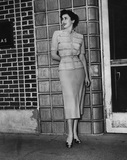 Joy’s work was often featured on the pages of Mademoiselle and Women’s Wear Daily magazines and all the fashion trade newspapers. Major upscale retailers such as B. Altman & Co, Sak’s Fifth Avenue, Sakowitz, J.W. Robinsons, I. Magnin, Marshall Fields, Bullocks, Burdines, May Co. and Lord and Taylor, to name only a few, featured Joy Kingston fashions in their stores and in their own newspaper advertising. Privately owned regional stores in major markets all over the US also clamored for the Kingston label. Fashion industry trade papers regularly extolled the virtues of Joy’s skill and craftsmanship with glowing reviews. Each season she unleashed new designs that were unquestionably trend setters. Her fashions were found in the wardrobes of Hollywood celebrities, such as Broadway and film actress Patricia Neal. Singer Abbe Lane, wife of band leader Xavier Cugat, was said to be so enamored with Joy’s fashions that she had purchased so many pieces while on tour she had to buy additional luggage to transport it home.
Joy’s work was often featured on the pages of Mademoiselle and Women’s Wear Daily magazines and all the fashion trade newspapers. Major upscale retailers such as B. Altman & Co, Sak’s Fifth Avenue, Sakowitz, J.W. Robinsons, I. Magnin, Marshall Fields, Bullocks, Burdines, May Co. and Lord and Taylor, to name only a few, featured Joy Kingston fashions in their stores and in their own newspaper advertising. Privately owned regional stores in major markets all over the US also clamored for the Kingston label. Fashion industry trade papers regularly extolled the virtues of Joy’s skill and craftsmanship with glowing reviews. Each season she unleashed new designs that were unquestionably trend setters. Her fashions were found in the wardrobes of Hollywood celebrities, such as Broadway and film actress Patricia Neal. Singer Abbe Lane, wife of band leader Xavier Cugat, was said to be so enamored with Joy’s fashions that she had purchased so many pieces while on tour she had to buy additional luggage to transport it home.
At the pinnacle of Joy’s success in the early 1950’s she made some surprising and life altering decisions. She closed Joy Kingston of California, married a fashion industry sales representative and and began a glamorous new chapter of her life in New York City. Living in New York had been a dream of Joy’s since she attended the 1939 New York World’s Fair at 17 years old. After her wedding in Kansas City, Missouri and her honeymoon in Cuba, she and her new husband took up residence in a lavish new 5th Avenue apartment. Joy could hardly wait to be near Broadway, Carnegie Hall, The Met and of course the best shopping in the world, all just footsteps from her front door. Once her new abode was sufficiently decorated and all her wedding gifts were unwrapped, Joy returned to work in fashion as a designer for Paul Adler, Inc.
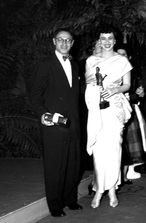 Sadly, neither her New York City adventure nor her marriage lasted by mid 1952. After a few months back at home in Kansas City with her parents, Joy returned to Dallas. There, she resumed her previous role at Nardis and was received with great welcome and fanfare. Not only were the executives at Nardis thrilled with her return, but so were all the buyers of the previous Madea, Nardis and Joy Kingston of California lines. Joy swung back into action and promptly delivered one of her best seasons of style yet. That year, Joy was honored with the prestigious “Dallas Alice” play clothes award for top design in the active sportswear category. As stated in the trade papers: “What the Oscars mean to Hollywood – The Dallas Alice means to Dallas”. Joy also became the treasurer of Dallas Fashion Arts, Inc., an organization dedicated to the elevation of good taste in the fashion arts, benefitting the fashion research division of the Dallas Public Library.
Sadly, neither her New York City adventure nor her marriage lasted by mid 1952. After a few months back at home in Kansas City with her parents, Joy returned to Dallas. There, she resumed her previous role at Nardis and was received with great welcome and fanfare. Not only were the executives at Nardis thrilled with her return, but so were all the buyers of the previous Madea, Nardis and Joy Kingston of California lines. Joy swung back into action and promptly delivered one of her best seasons of style yet. That year, Joy was honored with the prestigious “Dallas Alice” play clothes award for top design in the active sportswear category. As stated in the trade papers: “What the Oscars mean to Hollywood – The Dallas Alice means to Dallas”. Joy also became the treasurer of Dallas Fashion Arts, Inc., an organization dedicated to the elevation of good taste in the fashion arts, benefitting the fashion research division of the Dallas Public Library.
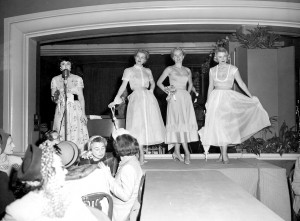 From 1956-1958, Joy once again returned to Los Angeles, California where she worked for several firms including Capri of California, Barnett Originals and Murray Millman. Then, she accepted a freelance assignment in New York City at Margot Dress Company. Upon her return to Los Angeles she designed for a series of companies including: California Girl, Inc., Ted Small Inc., Jean Andre, Sportsmasters of California and Jerry Mann. In 1964, Joy for the third time in her extensive career, threw her hat in the manufacturing ring and opened a new company: Faustina by Joy Kingston. While Joy was renowned for sportswear, Faustina by Joy Kingston was a more expansive line of clothing including day, evening, and formal wear. Her evening wear was influenced by the work of her favorite designer, Norman Norell. Joy’s flair for the unique and stylish was still evident in her line, but Faustina was shuttered by 1966, and would be the last fashion line to bear the Joy Kingston label. Joy later joined the firms of Norman Wiatt, H. Howard Hirsh, Jaybro and Mode O’day over the remaining 15 years of her career until her retirement in 1979.
From 1956-1958, Joy once again returned to Los Angeles, California where she worked for several firms including Capri of California, Barnett Originals and Murray Millman. Then, she accepted a freelance assignment in New York City at Margot Dress Company. Upon her return to Los Angeles she designed for a series of companies including: California Girl, Inc., Ted Small Inc., Jean Andre, Sportsmasters of California and Jerry Mann. In 1964, Joy for the third time in her extensive career, threw her hat in the manufacturing ring and opened a new company: Faustina by Joy Kingston. While Joy was renowned for sportswear, Faustina by Joy Kingston was a more expansive line of clothing including day, evening, and formal wear. Her evening wear was influenced by the work of her favorite designer, Norman Norell. Joy’s flair for the unique and stylish was still evident in her line, but Faustina was shuttered by 1966, and would be the last fashion line to bear the Joy Kingston label. Joy later joined the firms of Norman Wiatt, H. Howard Hirsh, Jaybro and Mode O’day over the remaining 15 years of her career until her retirement in 1979.
Joy loved California and viewed it as her true home. She lived in the communities of Los Feliz and Beverly Hills. She invested a great deal of time and attention to decorating and antiquing. Her home showcased her talents and was a source of great pride. She still enjoyed the thrill of the creative process in every way, shape and form. In addition, she was actively interested in fine art, art auctions, classical music, genealogy, gardening, jewelry design, investing, and of course, her many pets.
Still with an eye for all things beautiful, Joy died peacefully on January 30th, 2010 at the age of 87 in the care of her cousin, fellow designer and close friend, Paul Matthew Layne. As she had requested, Joy was laid to rest near her beloved parents in Rose Hills Cemetery in Kansas City, Missouri. Joy Kingston will always he remembered as a trail blazer in the fashion industry as well as a savvy business professional. Her impact on the realm of ladies sportswear and fashion in general was profound. She pursued excellence in every aspect of her life, and was a woman of great drive, accomplishment and perseverance. Joy’s legacy stands as an example for all young designers that follow in her footsteps.






















































